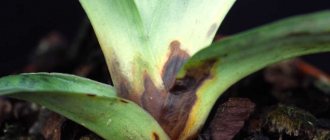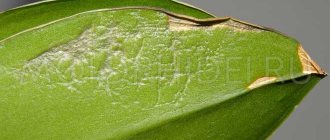Symptoms and causes of the disease
Accurate knowledge of the causes of flower disease will help you understand how to save the orchid and provide it with proper care.
Orchid diseases:
- Problems with flowering. There are three main ones:
- doesn't bloom
- buds may wither or rot,
- Dark spots appear on the flowers.
A healthy orchid in the right conditions
- Various rots:
- Brown bacterial. In this case, the leaves begin to rot.
- Rotten roots. In most cases a transplant will be required.
- The leaves may rot and become covered with a gray or black coating - this indicates the presence of fungi.
- Fusarium rot - leaves begin to turn yellow.
- Leaf diseases:
- Anthracnose. The leaves are infected by a fungus and become covered with small black spots. This happens due to stagnation of water in the leaf axils.
- Bacterial spotting. First, the leaves turn yellow, then they can rot, then they soften, crack, and can dry out and fall off.
- Leaf deformation, lost turgor.
- Leaf burn. Often occurs in the summer. If you do not put the orchid in the shade in time, the leaves will die very quickly, forming holes at the burn sites.
- Powdery mildew. The plant becomes covered with a white coating and will soon die if no action is taken.
- Viral diseases. They do not manifest themselves for a long time, cannot be treated, and the flower will have to be destroyed.
Important! As soon as a virus is detected in an orchid, it should be immediately removed from other plants and destroyed. If watering is common in one container, then other flowers are probably infected. In this case, they must be treated with antibiotics.
The causes of diseases can be:
- A virus or fungus can be introduced using tools.
- Overheat.
- Over or under watering.
- Incorrect amount of feeding.
- Parasites, insects in the soil.
- The substrate has not changed for a long time.
- Bad light.
Yellowing of foliage
This problem is encountered more often than others when growing orchids. Yellowing of the leaves can be caused by various reasons, but usually it is simply improper care or not the most suitable conditions.
Due to rotting roots
To eliminate the possibility of rotting roots, check them immediately. It is easy to distinguish rotten parts from healthy ones: they are dark, brown, limp, slightly soaked, and wrinkled. If the problem is in the roots, the plant requires an urgent transplant with the removal of rotten parts.
Due to overheating
Foliage may also turn yellow due to too high an air temperature in the room. Most often, this happens if in winter the pot is located near radiators.
Remove the container with the plant away from the battery and leave it alone for a while. After 3-4 days, the flower usually recovers on its own. To avoid a recurrence of such a problem, do not place the pot near radiators or other heat sources. And you just need to keep the orchid on the windowsill, shading it from direct rays.
Lack of light
Sometimes it affects the disease of the plant and its maintenance in insufficient light. If the orchid does not have enough light, it will react to this with wrinkled leaves, their small size and dull color. In general, the flower will look unhealthy and drooping.
How to revive rotten roots
Aerial orchid roots: transplantation and other options
How to revive an orchid if all the roots have rotted is not an easy question and requires special work.
You should understand! Rotten roots can no longer be saved, so they will need to be regrown.
Steps to solve the problem:
- Remove the flower from the pot
- Clear the root system of soil and rinse thoroughly.
- Trim off all rotten rhizomes using disinfected tools (knife or scissors). Only healthy tissue remains.
- Treat the sections with crushed charcoal and fungicide.
- If mold is detected, immerse the plant in a solution of potassium permanganate for a few minutes.
If the roots still remain after treatment, then it is necessary to transplant the plant into a substrate, but into a small pot. Be sure to provide the orchid with good lighting and a constant temperature of 22-25 degrees.
The orchid's roots are rotting
How do you understand that Phalaenopsis has begun to perish and die?
You can determine that an orchid is experiencing problems by its appearance. It is worth paying attention to the presence of the following signs:
- sluggish, gradually yellowing leaves;
- yellowing of shoots, starting from the crown;
- absence of buds (more than 3 months);
- changing the position of the plant in the pot;
- drying and hanging of aerial roots;
- green plaque and algae inside the pot.
If at least one of these signs is present, it is worth removing the flower from the flowerpot and inspecting the root system. Signs of problems with roots:
- brown or black color;
- soft to the touch;
- release of liquid when pressed;
- filamentous structure.
Orchid without roots
How to revive an orchid at home when all its roots have rotted:
- Use regular drying and dosed watering;
- Using mini-greenhouses.
How to prune an orchid after flowering: options at home
After all rotten roots are removed, the orchid is treated with any root growth stimulator.
Additional Information. “Kornevin” for orchids is a root growth stimulator and is often used to solve the problem. This is a hormonal biological preparation that stimulates root formation.
Pour water into a regular glass, adding sugar or honey (1 teaspoon per 1 liter). Then the rosette of the plant is placed in the glass so that the leaves do not come into contact with the water, and the lower part is completely immersed in it. After 8 hours, the water must be drained and the flower dried. Afterwards, be sure to treat the rosette with a root growth stimulator.
A mini-greenhouse is the most effective way to resuscitate a plant in the absence of a root. Take a small container where the flower will be rooted, filling the bottom with expanded clay and the top with sphagnum. Place the rosette on the prepared substrate and place the container in the greenhouse.
Phalaenopsis leaf without roots
Be sure to comply with the following conditions:
- Temperature – 22-28 degrees,
- Lighting – up to 14 hours a day,
- Humidity – at least 70%.
The greenhouse must be ventilated and the soil moistened. After a couple of weeks, roots will begin to grow. After they reach 4-5 cm, you can plant the plant in the substrate.
Root rot
A very dangerous condition that can lead to the death of the flower. Most often, three reasons lead to root rotting:
- fine, crumbly substrate;
- lack of light;
- high humidity.
Let's consider all of the above reasons in more detail.
Substrate
All flower growers know that the substrate for orchids has a special composition: it is fibrous and consists of individual fragments. Therefore, it is important to choose high-quality soil, with elastic particles that do not lose their shape.
The fragments should not quickly disintegrate into fibers or crumble heavily. When this happens, small particles of the substrate begin to rot, decompose, and mold: as a result, instead of well-absorbing soil, a mushy substance forms in the pot. The roots of the orchid, being in such a substrate, rot. Soon the flower may be left without roots at all.
To cope with the problem, you need to fill the container with fresh substrate, consisting of intact fragments that have not lost their elasticity. It is important that the substrate allows both moisture and air to pass through well.
Lighting
When keeping an orchid warm, it requires a lot of light. Moreover, the higher the air temperature, the more lighting the flower needs. For wintering, choose the lightest window sills in the house, since when the batteries are running, the plant’s need for light is especially great.
If the orchid is kept warm, but in partial shade, this will inhibit the development of its root system and lead to rotting and yellowing of the leaves.
Humidity
The orchid should be grown at very high air humidity - as much as possible in principle. It is clear that in an apartment it is not always possible to provide tropical conditions, but whenever possible, at least carry out regular spraying. The sprayer should be small, preferably dispersed. It is important to ensure that water does not get into the leaf sinuses during the procedure. Otherwise, the leaves of the plant may also rot.
Keep a distance between waterings: it is important to prevent moisture from stagnating in the soil. Between moistening procedures, the substrate should have time to dry well and ventilate. Stagnant moisture can be identified by the musty smell emanating from the pot.
Withered leaves
Is it possible to keep an orchid at home: options why it’s good or bad
When you have managed to grow the roots of the orchid, you can plant the flower in a pot with soil. However, there are situations when the leaves of a plant begin to wither and they stop holding their shape.
Loss of leaf turgor
How to save an orchid without roots and with limp leaves:
- Start growing roots.
- If there are rotten parts of the leaf, they should be cut off and the sections treated with charcoal, brilliant green or cinnamon. Then dry for about eight hours.
- Create conditions for regeneration and revitalization of the flower.
- Droopy leaves are restored with the help of compresses: the bandage is soaked in succinic acid.
Additional Information. Succinic acid is often used as a fertilizer for orchids. This is a salvation in many cases, especially if the plant is withering. Succinic acid is an absolutely safe biostimulant that will help “revive” the flower and restore it after suffering stress.
Often, old leaves do not regain their shape, but turn yellow and fall off. Instead, new strong and strong leaves grow.
Natural process
But do not forget that the orchid does not belong to evergreen plants and its leaves tend to turn yellow and fall off over time. The flower goes through nature's renewal of all its parts in accordance with its life cycle. In this period:
- the lower leaf plates gradually age;
- lose their green color and dry out;
- a new leaf is born.
Replacement occurs slowly, when one row begins to die off, the rest of the mass continues to turn green until its turn comes. During such a period, you should not rudely tear off the yellowed leaf; you should wait until the stem transfers life-giving juices to the flower and dries completely. Then, with a light touch of your finger, the dead part is removed without injuring the trunk.
Resuscitation at home
Reanimating an orchid at home requires a lot of patience and painstaking care for the plant. It is imperative to prepare all the conditions for reviving the flower and further maintenance.
Additional Information. When there is too much light, the plant's leaves turn bright green. Diminish the amount of light until the leaves turn pale green again.
Conditions of detention
Phalaenopsis requires the following maintenance conditions:
- Lighting – diffused, without bright sunlight.
- Temperature – avoid drafts and air conditioning.
- Humidity – 60-70%.
- Watering is regular. You can’t overfill a flower or place a pot with a plant in a basin of water for 25-30 minutes 1-2 times a week.
- The right soil. You can buy soil at the store and add pieces of expanded clay, oak bark and charcoal to it.
- Feeding. Fertilizers should contain nitrogen, phosphorus and iron.
Note! The most difficult period for phalaenopsis is autumn-winter. The air temperature drops significantly outside, causing the heating to turn on at home. In this case, the temperature in the rooms rises, the air becomes less humid. Also, the color day is shortened, so the orchid receives less sunlight.
Conditions for recovery
In order for the orchid to recover without problems, the following conditions must be observed:
- Watering must be very careful.
- You should not fertilize the flower for about a month after “revival” to avoid a negative reaction. Afterwards, introduce fertilizing gradually.
- Control the presence of pests.
- Use only high-quality substrate.
- Maintain comfortable living conditions for the orchid.
The main reasons why phalaenopsis buds fall off
The answer to the question of why the buds on an orchid fall off is quite simple. This is non-compliance with the conditions of keeping and growing. Any discrepancy between the microclimate in the house and that required by the orchid can lead to such a sad consequence as the loss of buds and flowers. Let's look at each aspect in more detail.
Low humidity
Although phalaenopsis does not require high humidity and feels comfortable at 40-50%, dropping the air humidity level below this level will lead to a deterioration in its health.
Externally, it is not immediately possible to determine the cause, since the plant does not fade abruptly. However, it will be almost impossible to stop the process of shedding buds.
As a rule, this happens during the heating season, when heaters evaporate all the moisture from the air. This leads to the orchid’s flowers falling off. Therefore, during the winter period, it is recommended to additionally humidify the air by any available means: humidifiers, containers with water, spraying.
Violation of the watering regime
Lack of watering is a fairly common reason why orchid buds fall off. But it is worth noting that, unlike a lack of moisture, the need for watering can be diagnosed quite quickly. Timely measures will save the flowering and preserve the remaining buds.
The appearance of the plant shows when it needs urgent watering. The leaves don't look very attractive. They become depressed and may dry out. The buds and flowers themselves lose their elasticity and become softer to the touch. You can notice that they begin to hang, looking down, not towards the light.
In this case, you need to urgently water the plant. Place its pot in a container of water for at least 30 minutes. Then you can spray the leaves. After this, immediately return the flower to its usual place. If measures were taken not too late, the flowers will be transformed again and become fresh.
Lack of lighting
Phalaenopsis orchids are demanding in terms of the amount of light and the length of daylight hours. If there is insufficient light, they simply will not begin to bloom. When the daylight hours increase by at least 1-2 hours, the flower understands that it is time to start blooming. However, if the daylight hours end up being less than 12 hours and does not increase further, then flowering will stop.
This will serve as a signal to the phalaenopsis that the time for flowering has not come, and it will drop its buds. This behavior can be difficult to predict. Therefore, it is better to make sure in advance that the light reaches the flower for at least 12-14 hours in a row.
Temperature violation
With minor or short-term temperature changes, the orchid does not shed its buds. But if the room was stable at +23, and then you decided to reduce the temperature there to 19 degrees, and it stays at this level constantly, then the flower will most likely consider that the warm season is over and it’s time to prepare for the resting phase.
The resting temperature for phalaenopsis is about 18 degrees. That is, the closer to this mark, the higher the risk of stopping flowering.
But even very high indicators do not benefit phalaenopsis. Already at 30 degrees the process of flowers withering begins
So it is important to choose the optimal temperature and maintain it constantly
Drafts
Sometimes the reason why an orchid drops flowers is not at all clear. It seems that the conditions have been good and stable. But suddenly, the buds begin to fall off.
You need to understand that phalaenopsis is a rather capricious and wayward plant. There is no direct connection between a draft and the falling of buds. However, the flower may not be comfortable - the air may be too cold, or, conversely, too hot. As a result, flower loss is possible. But it is worth noting that this is a fairly rare reason.
Aging
It may also be that the orchid is old and its energy supply is not enough to complete the flowering stage. The situation is quite unusual, since with proper care, timely transplants and treatments, this can be completely avoided.
Stress from changing conditions
Unopened buds quite often fall off if the conditions of keeping the flower are changed. It is not uncommon to see flowers fall from a recently purchased plant. And the reason for this is usually a change of situation.
This can be avoided by providing the flower with excellent care from the first day and a microclimate as close to natural as possible.
It is also undesirable to rearrange the flower inside an apartment or house. If you want to do this, then you need to wait until flowering completes and enters the resting phase.
But this often happens when you want to put a blooming flower in a more prominent place. But the result is the opposite - after a few days it loses all the flowers and buds.
Care instructions
Some time after the plant has been restored, buds will begin to appear. A wilted peduncle should be removed after the petals have fallen. If you cut the stems too early, new ones will be able to form only after six months.
During the dormant period, the flower is placed in a warm, not very lit place. After pruning, the orchid usually rests for two months.
Orchid in a transparent pot
Required rest care:
- Don't deprive the light.
- Temperatures during the day – up to 24 degrees, at night – up to 16.
- The frequency of watering decreases. In winter you can only spray.
- In order for the buds to form, you can create a stressful situation - a temperature contrast. At night it should drop to 4-6 degrees.
- Fertilize 3-4 weeks after transplantation.
How quickly the orchid will bloom again depends on how well the care was carried out during the resting phase.
Always before starting resuscitation, it is worth studying all the methods and choosing the appropriate one. Only if the procedure is performed correctly will the flower not disappear further; on the contrary, it will be able to remain viable. Then more than once he will delight his household with beautiful blooms.
Use of growth stimulants
To make orchid roots grow faster, experienced gardeners use growth stimulants when resuscitating the plant. These drugs not only activate root growth, but also increase the plant’s immunity, which is also important.
Epin and Zircon
The popular Epin is most often used as a suitable stimulant; many also like Zircon. Epin is diluted in the following proportion: 1 drop of the drug per liter of water. The flower is soaked in the resulting solution for 20 minutes if the damage to the roots is minor. If there are almost or no roots left, the stimulation time must be increased to 1.5-2 hours.
succinic acid
In addition to Epin and Zircon, Succinic acid is also very popular. The product is very helpful in activating root formation and regrowth of green mass. The proportion in this case is as follows: a tablet of the drug per liter of water. Use the product to spray the plant and water it, but not more than once a month.
Kornevin
The product is well known to flower growers. It is usually used when it is necessary to revive a phalaenopsis orchid. Kornevin is diluted in water according to the instructions, after which the lower part of the plant is placed in the solution. The drug has a remarkable effect on the flower’s immunity, activates its vitality, and promotes speedy recovery.
Fitosporin
The drug is indispensable when you have to revive an orchid after fungal diseases. In this case, the plant is soaked in the drug solution for 15-20 minutes, after which it is planted in a vase, greenhouse or pot.
Signs of a dying plant
The flower will definitely give a signal that its health has deteriorated. First of all, the leaves will begin to wither and dry out. The growth of the orchid will also slow down. As soon as you notice these signs, you need to immediately begin resuscitation.
First of all, inspect the roots. The state of the root system can tell you a lot. Ideal shoots should be light in color and covered on top with velamen, a greenish substance. This shell not only protects the roots, but also takes part in the “feeding” process.
Rescue without a greenhouse
If a greenhouse is not at hand, the orchid can be revived without a greenhouse. To begin with, we again remove the dead parts and treat the cut areas with an antiseptic. Pour filtered water into a small vessel and place the plant there.
It is important that the leaves are above the water. The liquid needs to be changed daily; for intensive growth, you can add a little sugar. When the roots grow, we transplant the orchid into the substrate.
If the cause of wilting is overheating. The flower is moved to a cool and shaded place. After some time, the orchid can be watered with settled water. The orchid should recover within a few days.
The wrong substrate is simply replaced with a new one. To do this, you need to replant, completely removing the old soil from the roots.
Is your flower dying due to pest attack? The plant will have to be replanted. The roots must first be thoroughly washed. After planting in a new substrate, you should not water the orchid for another two weeks so that the insect larvae are sure to die.
Drying of flower stalks
A similar problem happens with an orchid if:
- it is not watered enough;
- overfed.
Depending on the reason causing the negative factor, appropriate measures are taken:
- make watering more abundant and frequent;
- minimize fertilizing.
In the latter case, to save the orchid, a transplant may be necessary: if too much fertilizer has been applied.











